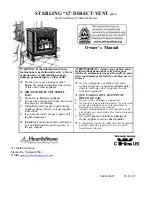
www.fmiproducts.com
55173H
10
To install:
1. Remove gas line cover plate from appliance’s
outer surround at the location to be used.
2. Remove insulation from inside the gas line
conduit sleeve.
3. Run gas line through sleeve.
4. Prepare incoming black iron gas line with
Teflon tape or pipe joint compound. (Check
local codes as to the use of Teflon tape.)
CAUTION: Compounds used
on threaded joints of gas piping
shall be resistant to the action
of Liquefied Petroleum (LP or
propane) and should be applied
lightly to ensure excess sealant
does not enter the gas line.
5. Connect incoming gas line to regulator. Secure
all joints tightly with wrench, but do not over
tighten. If a flexible gas line is used, take care
not to kink the connector.
6. Re-pack insulation in and around the conduit
sleeve and flexible gas line.
WARNING: All gas piping
and connections must be tested
for leaks after the installation is
completed.
After ensuring that the gas valve
is on, apply a commercial leak
detection solution to all con-
nections and joints. If bubbles
appear, leaks can be detected
and corrected.
Do not use an open flame for leak
testing and do not operate any
appliance if a leak is detected.
Typical Exterior Wall Gas
Shutoff Installation
Key
Extension
Shutoff
Valve
FIREPLACE
INSTALLATION
Continued
Figure 15 - Typical Exterior Wall Gas
Shut-Off Installation
LOG SET PLACEMENT
Carefully remove log set from packaging. Place
the two bottom logs over grate and align with pins.
Place three loose logs, or twigs, onto alignment
pins on two bottom logs (see Figure 16).
Figure 16 - Log Placement
FIREPLACE FACING
Any non-combustible material may be used for
facing (glass, tile, brick, etc.) as long as the proper
clearances are adhered to and the fireplace open-
ings are not blocked or obstructed in any way. See
Clearances
, page 6, and Figure 17 on page 11.
Use only heat-resistant, noncombustible mortar
or adhesive when securing facing material to the
front of the fireplace.
Bottom Logs
Top Logs (Twigs)






































